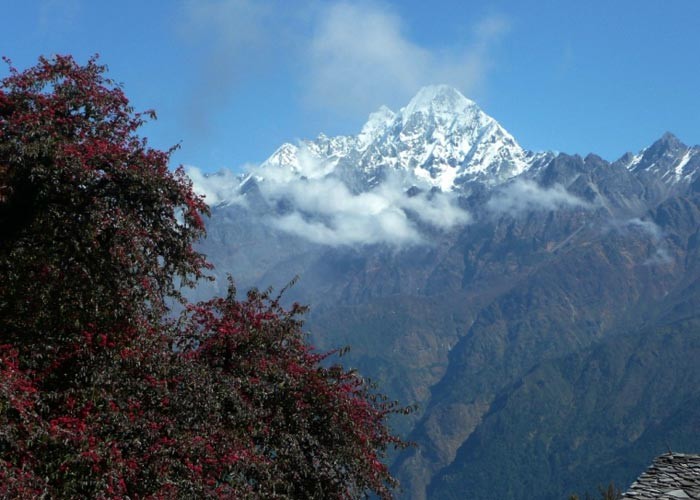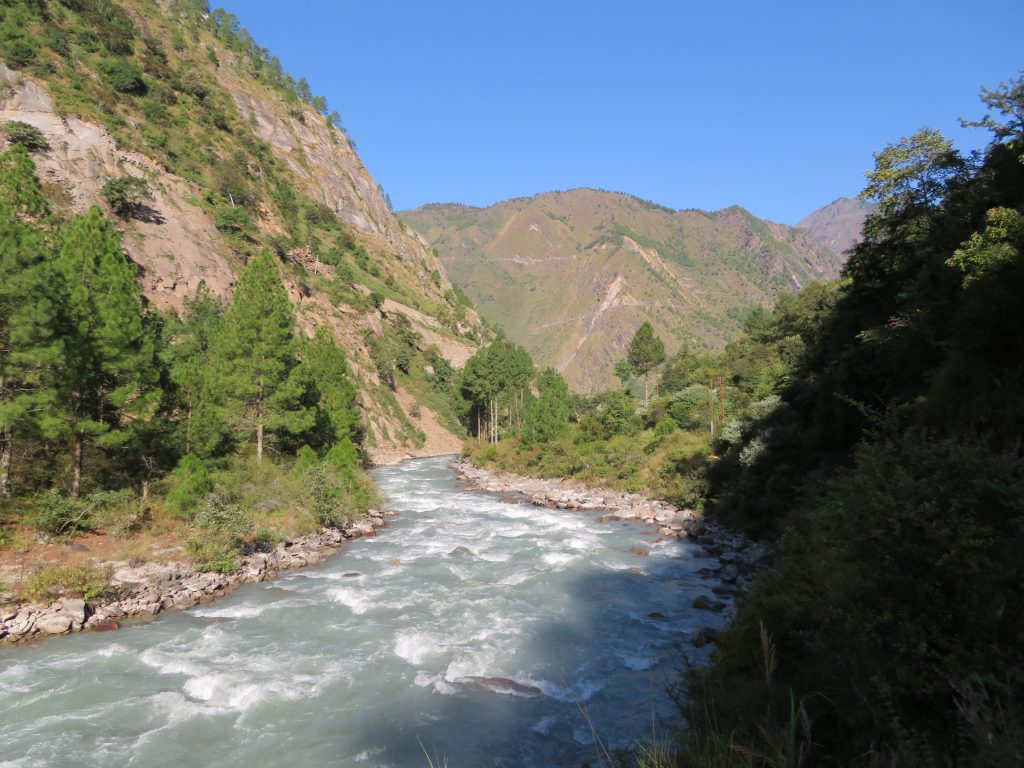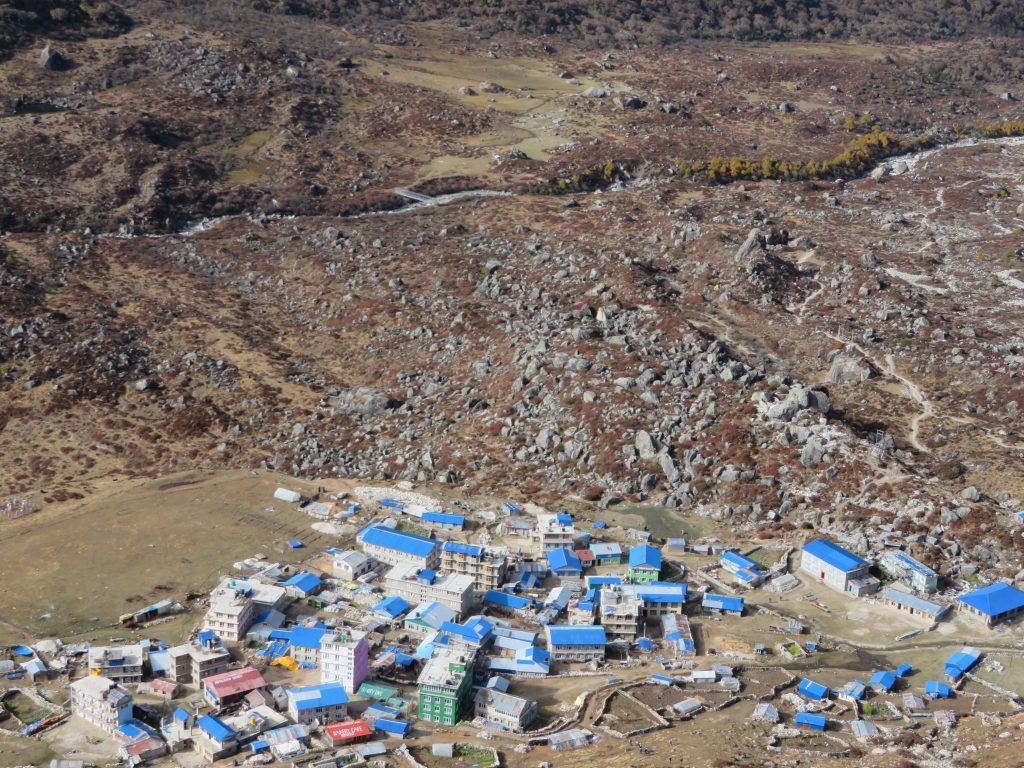Lying north of the Kathmandu Valley, the Tamang Heritage Trail is easily accessible compared to many other treks in Nepal. A chance to experience some of the most beautiful scenery in the country—terraced green farmland, thick forests, and the peaks of the Langtang Himalayas. The trail is adjacent to the Langtang Valley on the border with Tibet. It is a lovely journey through virtually undisturbed virgin trails. Hike through quaint hamlets where ancient monasteries are waiting to be discovered. The journey follows the majestic folds of Langtang and Ganesh Himalayan Range. Not so long ago Langtang was one of Nepal’s hidden regions, home to some of the most exquisite and authentic people in Nepal. The Heritage Trail borders Tibet and provides some majestic views of the Himalayas including Langtang Lirung (7,227m), Ganesh Himal (7,422m), along with countless other snow-capped peaks of the Himalayas.This journey provides is a real opportunity to learn more about the authentic culture and ways of life of the Tamang people. Discover their ancient customs that have been passed down over many generations.
Himalaya Heart provides total support to you all the way. Our mountain guides have spent many years leading groups and are well able to deal with any problems. Our teams are always well prepared, we provide our porters and support staff with excellent equipment for travel into the mountains. Your trip leader will be paying careful attention to all clients and staff, making sure everyone stays as comfortable as possible and has the best chance of attaining their goals and completing the trip successfully.
- Experience one of Nepal’s Tibetan-influenced hill tribes, and directly contribute to their rural economy
- Soak in the hot spring waters at Tatopani
- Stay in a local homestay in Briddim, to learn more about the Tamang people and their way of life
- Enjoy spectacular views of Ganesh Himal, the Langtang Himalayas, and the Gosainkund range
One of our team will receive you at Kathmandu International Airport for the transfer to your hotel. After time to settle you will be introduced to your tour guide for a tour briefing. The rest of the day is free to explore this bustling city.
A full day sightseeing around the Kathmandu Valley touring its premium destinations that have managed to find a place in the UNESCO world’s heritage list. We begin with Swayambhunath climbing its stairs which are said to encompass the 13 paths to reach enlightenment. The Hindu heritage of Pashupatinath is next on our list resonating in the prayers of thousands who visit the temple each day. We head towards Kathmandu Durbar square to witness a historical journey encompassing generations of Nepalese Kings before ending our journey at Boudhanath well known for its sunset views. Overnight Kathmandu.
Today, we check out from our hotel for the overland journey to the trailhead at Sybrubensi. The traffic of Kathmandu is swiftly left behind as the bends of the highway come to our rescue. The day is very scenic one with splendid views of the Himalayan range on the way. Terraced farmlands ending at Sybrubensi our start point.. Overnight stay at Sybrubensi.
Our first day on the trail, we are greeted by the morning sun as we head towards Rongga Bhanjyang. We pass through dense forest descending gradually towards Goljung village. Accompanied by the peaking Himalayas beyond and the disappearing hills behind us, we continue towards Gatlang Village. The trail continues to rise before reaching Parvati Kunda. Overnight stay at Gatlang
We head to the picturesque village of Tatopani where there is a chance at the end of the day to bathe our tired legs in its hot springs. The journey out of Gatlang begins with a swift descent through a forested trail full of Sal, juniper and oak trees. Crossing the village of Chilime, we reach a suspension bridge beyond which lies Gonggang that lies above the terraced farmland. The final stretch of the trail takes us through more forest on our ascent to Tatopani. Overnight stay at Tatopani.
After an early morning soak in the hot water springs, we head towards the vibrant hamlet of Nagthali which at 3,165m is the highest point of the trek. The ragged forested trail begins its ascent reaching the quaint hamlet of Brimdang followed by another ascent to reach Nagthali. Overnight stay at Nagthali.
The trail today winds down through the familiar forests alive with wildlife including the elusive red pandas. We descend down to the village of Thuman and from here we further head down to the sandy banks of Bhote Koshi River. The trail continues alongside the river heading upstream to Lingling village beyond which lies Briddim an ideal homestay. Here we really gain an insight intoTamang culture and their unique way of life. Overnight stay at Briddhim.
Our final day of the journey is a short one as we make our way back to Sybrubensi. The journey begins with the usual stunning landscapes and viewpoints made even more captivating by the vibrant Tamang hamlets. Heading out through the forested trail and beside the familiar bends of Trishuli River eventually reaching Sybrubensi. Overnight stay at Sybrubensi.
Today our transport is waiting to drop us back to the hotel in Kathmandu reaching erly afternoon.We normally organsie a farewell dinner on the lat evening. Overnight hotel.
We hope you enjoyed your time with us. Our representatives will once again drop you back at Kathmandu International Airport as per your schedule and we hope to see you again.
Cost Included
- Pick up & drop off at arrival and departure to/from Kathmandu Airport.
- Two nights Hotel accommodation in Kathmandu with breakfast
- Guide (one guide for one group)
- Porter (one porter in between two people]
- Trekking Entry permit
- TIMS (Trekkers Information Management System)
- Breakfast, lunch & dinner during trek
- Accommodation during the trek
- Road transportation
- Insurance for guide & porter that includes their emergency rescue
- Necessary equipment for guide & porter
- Emergency rescue arrangement (Makes sure your insurance will cover it)
- First aid kits
Cost Not Included
- International airfare and travel insurance
- Tips
- Meals in Kathmandu
- Alcohol and any drinks on trip (including bottled water)
- Hot shower and washing
- All expenses of a personal nature e.g. toilet paper, medicines, confectionery etc
- Nepal entry visa fee
Tamang Heritage Trail FAQ
You can bring your sleeping bag from home or you can rent one in Kathmandu or Himalaya Heart will loan you one. Most tea houses also have blankets but we suggest you bring a warm bag with a liner to use with the blankets.
You can leave your additional luggage at your hotel in Kathmandu or at our company office in Thamel. Either way, your luggage will be waiting for you at your hotel when you return back from your trek.
You can buy virtually everything you need for trekking from down jackets to water bottles in Kathmandu. There is a variety of branded stores as well as a large selection of copied products mainly in Thamel that are of fairly good quality. It’s still worth bringing your own gear if it doesn’t take up too much weight, especially your own trekking boots to avoid any potential issues when purchasing new shoes..
You should bring trekking boots that are comfortable and broken in. There can be some snow at higher altitudes especially when crossing high passes, so it’s good to be prepared for a variety of conditions. Your footwear should be strong and durable. It should have a chunky sole—preferably made of Vibram or another durable material—and should also protect your ankles..
Tipping is not required but is expected, and really depends on how happy you were with the service. Guides (both for trekking and cultural tours), porters, and drivers are typically provided with a tip at the end of their service with you..
Most days in the mountains involve 4-6 hours and longer of trekking. When you consider your day starts at 8 am and ends around 4-5 pm, it’s not too arduous as you’ll be taking a number of breaks and stopping for lunch along the way. The higher you get in elevation (especially in the Everest region), the shorter your trekking days will get to ensure we minimize the risk of altitude sickness.
You only need to carry your day pack with daily essentials (sunblock, water, hat, light jacket, and camera) Our porters carry the bulk of your gear, such as extra clothing and overnight essentials
All of our guides at Himalaya Heart speak English and have had many years of experience in guiding foreign travelers. It’s a requirement that they all are trained in first aid as well and we carry a first aid kit during the trek.
If you fall ill during your trek, the course of action depends on what’s wrong. If it’s altitude sickness, moving to lower altitudes and taking altitude medication will solve this in most cases; if it’s severe, our guide will arrange for an emergency evacuation by helicopter Himalayan Heart will cover the initial costs then claim from your insurer (be sure that emergency helicopter rescue is covered in your travel insurance it is an essential requirement before travelling with us). If you have stomach sickness or another type of food or water-related illness, our guide will have medication on-hand for most common illnesses
For group treks (treks that start on a specific date and are open for travelers to join), the group size can range from 2-10 people but typically ends up being around 4-6 people.
When’s the best time to visit Nepal?
The main seasons for trekking are the spring (Mar to May) and autumn (Sep to Nov) when you’ll have clear skies and superb mountain views. The winter (Dec to Feb) is also a great time to visit— these months offer a unique experience and fewer crowds but lower altitude treks are better at this time of year as its cold at night.
What’s it like during the monsoon season?
During the monsoon season (Jun to Aug), most of Nepal experiences heavy rain for a few hours each day. It’s humid, wet, and the trails in the lower regions (Ghorepani, Ghandruk, Langtang, etc) can be quite muddy. If you don’t mind the rain you’ll have the trails to yourself, the skies often clear up in the morning, and certain treks offer stone-paved trails that drain the rain and make for easy trekking. Also, certain regions, like Mustang and the upper reaches of Everest, lie in the rainshadow of the Himalaya and receive little rain but views however are still likely to be restricted.
What’s the difference between private and group tours?
Private tours are tailor-made itineraries built by us around your travel dates and personal interests, whereas group trips are pre-packaged and depart on specific dates. Group trips are also open for others to join, whereas private trips are just for you. You will find a list of fixed departure dates on our website.
How do I get my visa for Nepal?
For most nationalities, you can obtain it on arrival in Kathmandu. It takes around 45 minutes and is the most convenient way to get your visa you will need passport size photos.. You can also apply for a visa in advance from a local Nepali consulate in your country if you’d like to have everything arranged in advance. Cost15 Days – 25 USD / 30 Days – 40 USD / 90 Days – 100 USD
How much luggage can I take on domestic flights?
For mountain flights, you’re allowed 5 kg. carry-on to the plane and 10 kg. for checked-in luggage. For non-mountain sector flights, the check-in allowance increases to 20-25 kg.
Are hotels included in the tour price?
Himalaya Heart organises complete tours, meaning everything is taken care of from the moment you arrive in Nepal to the moment you leave, including all of your accommodation in a three star Hotel. If you require better accommodation please let us know and we can arrange this and adjust the tour cost accordingly. Each of our tour pages shows clearly what is and what is not included in the tour price.
Are there any extra expenses not included in my tour price?
Personal expenses (tips, soft drinks, bar bills, laundry, telephone calls, donations, and extra snacks, etc) are not included in your tour price. When checking a particular trek page on our website we have clearly stated what is and what is not included. If you’re going trekking, the only things you’ll need to pay for out of pocket are wifi and battery charging (when available), extra meals outside of what’s included, alcohol, and soft drinks and perhaps hot showers.

 +977 9851093973 (Thakur)
+977 9851093973 (Thakur)



